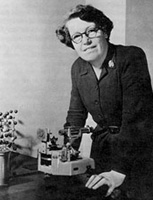Helen Megaw facts for kids
Quick facts for kids
Helen Megaw
|
|
|---|---|

Megaw circa 1950
|
|
| Born | 1 June 1907 |
| Died | 26 February 2002 (aged 94) |
| Nationality | Irish |
| Alma mater | Queen's University, Belfast, Girton College |
| Known for | Crystallographer who determined the structure of ice crystals and the Perovskite crystal structure. |
| Awards | The Roebling Medal of the Mineralogical Society of America. Megaw Island and the mineral Megawite (CaSnO3) are named after her. |
| Scientific career | |
| Thesis | (1934) |
| Doctoral advisor | J. D. Bernal |
Helen Dick Megaw (born June 1, 1907 – died February 26, 2002) was an amazing Irish scientist. She was a pioneer in X-ray crystallography, a special way to study how crystals are built. Helen Megaw figured out the structure of ice crystals and also discovered the important Perovskite crystal structure.
Contents
Early Life and Education
Helen was born in Dublin, Ireland. Even when she was in school, she loved science. She read a book called X-rays and Crystal Structure, which got her interested in crystals.
She studied at Queen's University, Belfast for a year. Then, in 1926, she moved to Girton College, Cambridge to study Natural Sciences. She graduated in 1930.
Studying Crystals with X-rays
After graduating, Helen became a research student. She studied crystallography under a famous scientist named J. D. Bernal. Her main focus was the structure of ice.
She earned her PhD in 1934. Girton College gave her a special scholarship. She used it to study in Vienna for a year, learning even more about crystals.
In 1935, Helen Megaw and J. D. Bernal worked together. They published an important method. This method helped scientists figure out where hydrogen atoms are located in crystals. It's known as the Bernal-Megaw model.
Career and Discoveries
Helen Megaw worked in different places. She spent some time teaching at a school. In 1943, she started working for Philips Lamps in London. There, she became an industrial crystallographer.
Discovering Perovskite Structures
At Philips, Helen worked on a material called barium titanate. This is where she started studying the perovskite crystal structure. She became a top expert on this type of crystal.
In 1945, Helen went back to work with J. D. Bernal for a year. After that, she joined the Cavendish Laboratory in Cambridge. She also became a Fellow and Director of Studies at Girton College.
Helen Megaw retired in 1972. She split her time between Cambridge and Ballycastle, County Antrim. She passed away in Ballycastle in 2002.
Books by Helen Megaw
Helen wrote two important books about her work. Her first book, Ferroelectricity in Crystals, came out in 1957. Her second book, Crystal Structures: a Working Approach, was published in 1973. These books helped other scientists learn about crystals.
Science and Art
In 1949, Helen Megaw had an interesting conversation. It was with Mark Hartland Thomas, who worked for the Council of Industrial Design. This led to Helen becoming a science consultant.
She worked for the Festival Pattern Group for the Festival of Britain in 1951. Helen was the main scientist in this group. They took images of crystals and gave them to designers. These designers used the crystal patterns in products. These products were shown at the Festival.
In 2019, some of Helen's fabric samples were displayed. They were part of an exhibition at the Science Museum, London. The exhibition was called "The Art of Innovation". It showed how art and science can work together.
Legacy and Awards
Helen Megaw's work is remembered in many ways.
Places and Minerals Named After Her
Because of her important work on ice crystals, an island is named after her. It's called Megaw Island and is located in the Southern Ocean.
A special mineral is also named after her. It's called Megawite (CaSnO3). This mineral is part of the perovskite group.
Awards and Recognition
In 1976, Helen gave some of her fabric samples from the Festival of Britain to the Science Museum, London. She also gave them a souvenir guide-book.
In 1989, Helen Megaw made history. She became the first woman to receive the Roebling Medal. This is a very important award from the Mineralogical Society of America. She also received special honorary doctorates. These were from the Universities of Cambridge and Queen's University Belfast.
See also
 In Spanish: Helen Megaw para niños
In Spanish: Helen Megaw para niños

